Things to do in Cuenca, Ecuador - Panama Hats and Shrunken Heads
Cuenca is a UNESCO World Heritage Site and the third largest city in Ecuador. It sits in the Southern Highlands, surrounded by Andean Mountains. Despite a wealth of things to do in Cuenca, most online articles discuss how expats can relocate or retire there. With our retirement scheduled far into the future, we almost didn’t visit. Destinations with nature, wilderness and wildlife usually take preference. Yet when it was time to head south for the Peru border, Cuenca seemed like a good place to break up the journey. I’m so glad we made this decision and spent a couple of days there. We could have stayed for many more.
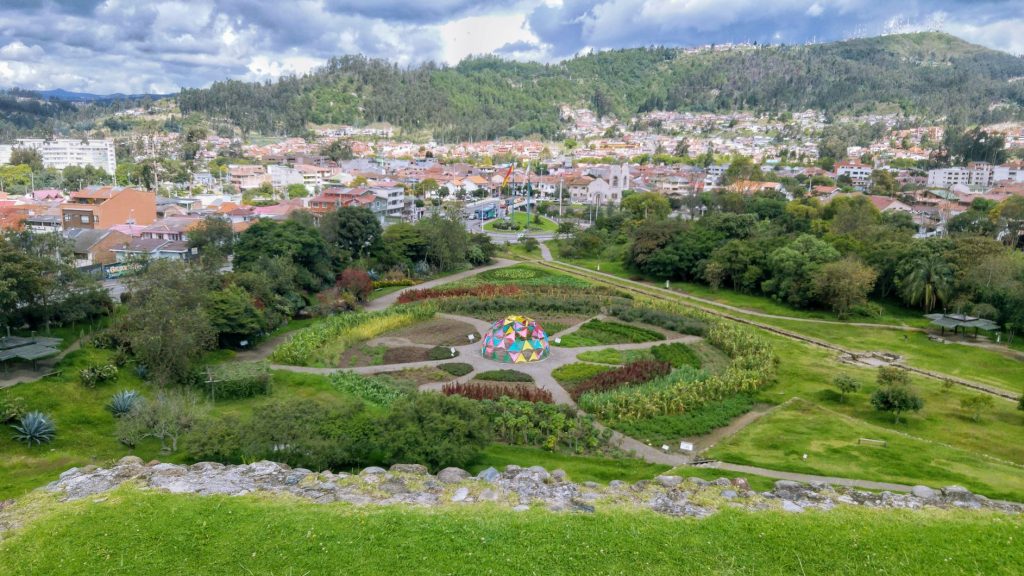
Not only is Cuenca a beautiful city, but there’s a relaxed old world feel you get when exploring its cobbled streets. People pass by in indigenous dress and local artisans sell their crafts. There’s bustling food and flower markets, ancient Inca ruins to explore and you can see the original Panama Hats being made. To top it off, there’s even real shrunken heads on display and Valium laced elixirs to make you feel better. Compared to Quito, which has developed into a bustling metropolis, Cuenca has retained its charm. More famous towns in South America can sometimes feel like a tourist style tribute to the places they once were. Yet Cuenca has maintained its character as the real deal.
Cuenca was a planned city and built in 1557 by the Spanish. To this day it still retains the same layout and hasn’t succumbed to rapid urban development. The population isn’t split into designated areas and people from all walks of life mix together. It’s a perfect place to explore.
Here’s what we got up to in Cuenca.
Catedral de la Inmaculda Concepción – The New Cathedral of Cuenca
Giant blue domes of imported Czech tile make this Cathedral an unmissable sight. Construction started in 1885 and it took nearly 100 years to complete. Taking that long, you won’t be surprised to learn that it’s one of the largest Cathedrals in South America. Building it wasn’t without problems though. It may not be noticeable to the casual admirer, but the domes on the Cathedral are the incorrect size. If constructed as planned, they would have been too heavy for the foundations to support them. Although the tallest is still an impressive 53 metres high and 12 metres wide!
It’s possible to visit the roof of The New Cathedral of Cuenca for $5 USD.

Plaza de San Francisco
This is a square where locals come to trade everything from fabrics to clothes. Although the outdoor section wasn’t as elaborate as I’d imagined, the indoor Artisan Market offers some truly unique crafts. Numerous tiny shops sell all manner of handmade goods, each as unique as the artist themselves. We saw everything from jewellery to paintings, hats to shoals and even recycled trash made into alien like robots. The artists are all so friendly too. The indoor market is a great place to find out more about their lives and culture (as long as you can speak Spanish).
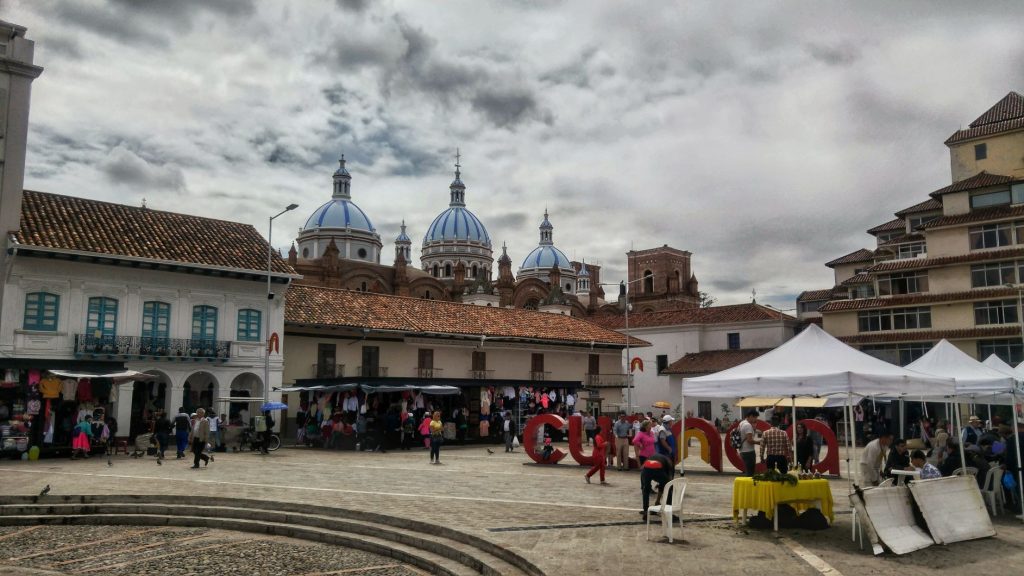
Mercado de Flores – Cuenca Flower Market
The Mercado de Flores (Cuenca Flower Market) at the side of the Santo Domingo Cathedral is small but interesting. I’ve no idea why National Geographic called it one of the Top 10 Flower Markets in the World. That’s quite frankly ridiculous. Yet the abundance of rich colours make for a pleasant visit.
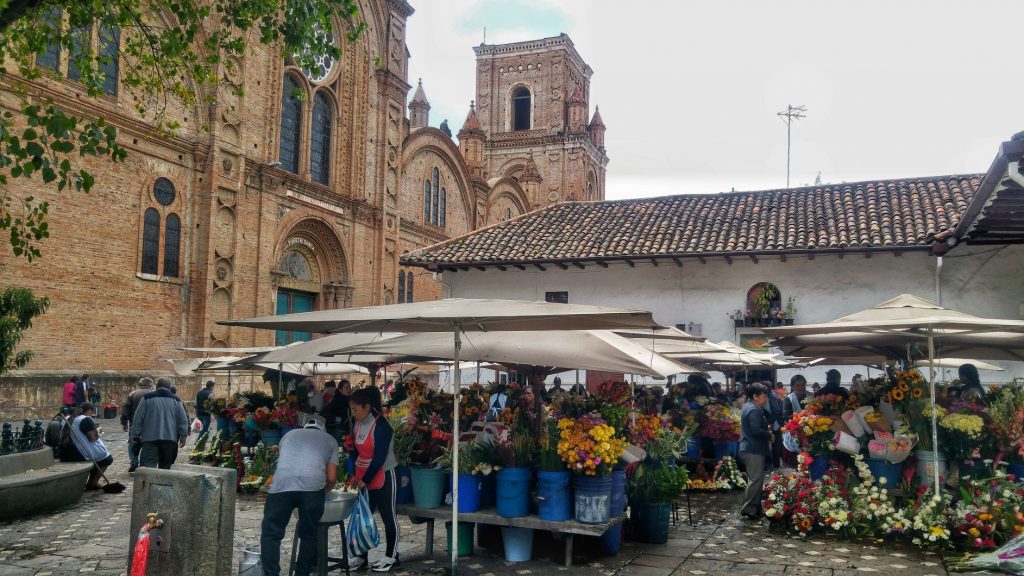
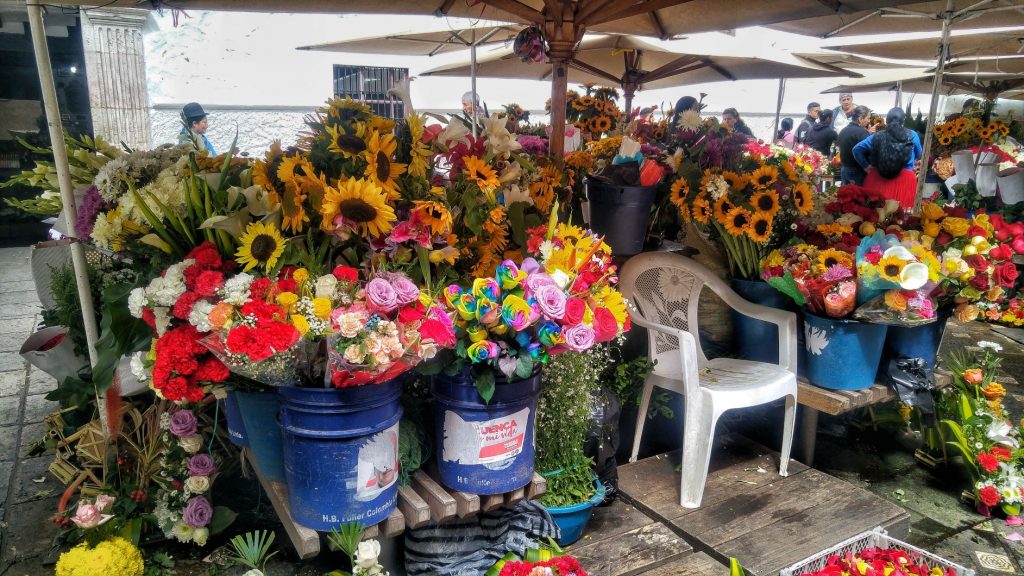
The real draw to Cuenca Flower Market is Agua de Pitimas. There’s a small hole in the wall where you can buy this magical elixir. A cup of this mystical concoction will only set you back $0.50. It’s said to help relax the mind and assist with anxiety, depression and wellness.
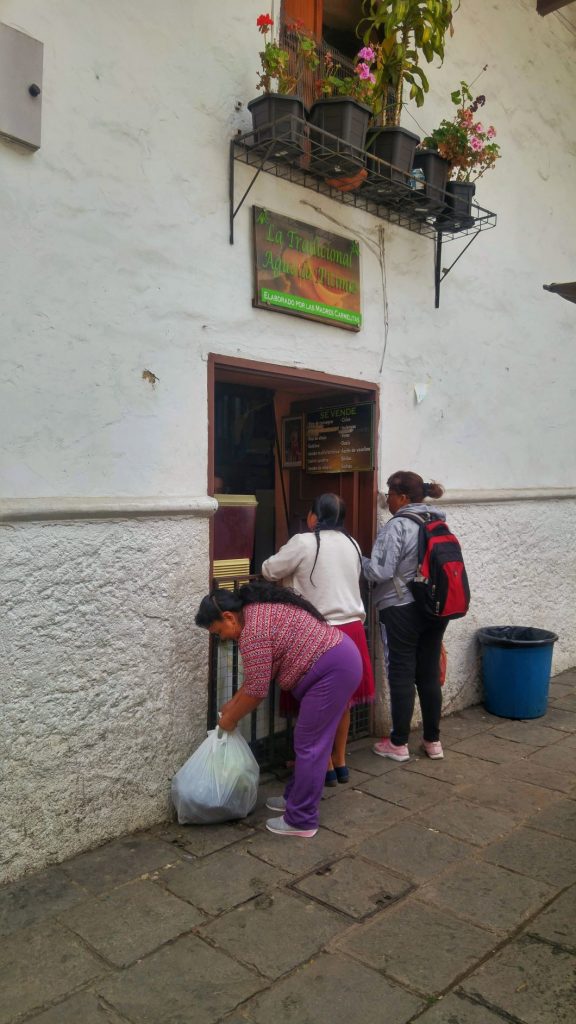
But what is Agua de Pitimas?
Well, the nuns of Cuenca’s Santo Domingo Cathedral are the only ones to know the secret recipe. Everybody else knows that Agua de Pitimas contains flowers. The scent is a dead give away! As for the calming side effect, there’s local rumours that it’s caused by drops of Valium. A small amount secretly poured into each barrel.
Nobody can prove if Valium is the secret ingredient. Yet it might help to explain the constant queue of locals waiting in line to knock back a cup. I loved it, but one sniff was enough to put Rose off. It’s worth trying and is a great cultural experience.
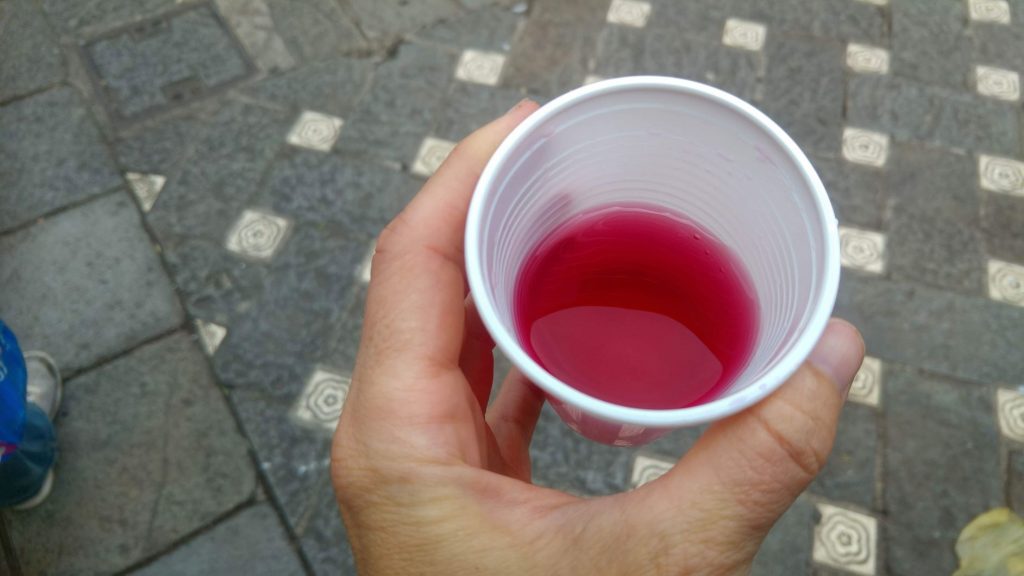
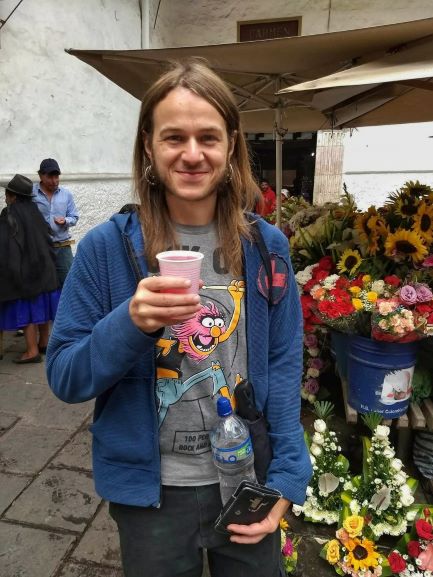
10 de Agosto Market
‘10 de Agosto Centro Municipal de Salud’ (or Cuenca Health Market) is a great place to explore and watch the locals. It is divided into sections for vegetables, fruit, meat, full roast hogs, fish, breakfast and lunches. Being a health market, I had one of the best smoothies in all my travels. For $1 I got a freshly made papaya and orange smoothie. It might sound like any other smoothie, but I could feel the vitamins livening up my body with every sip of the bright orange goodness. (Either that or the Agua de Pitimas had started to kick in).
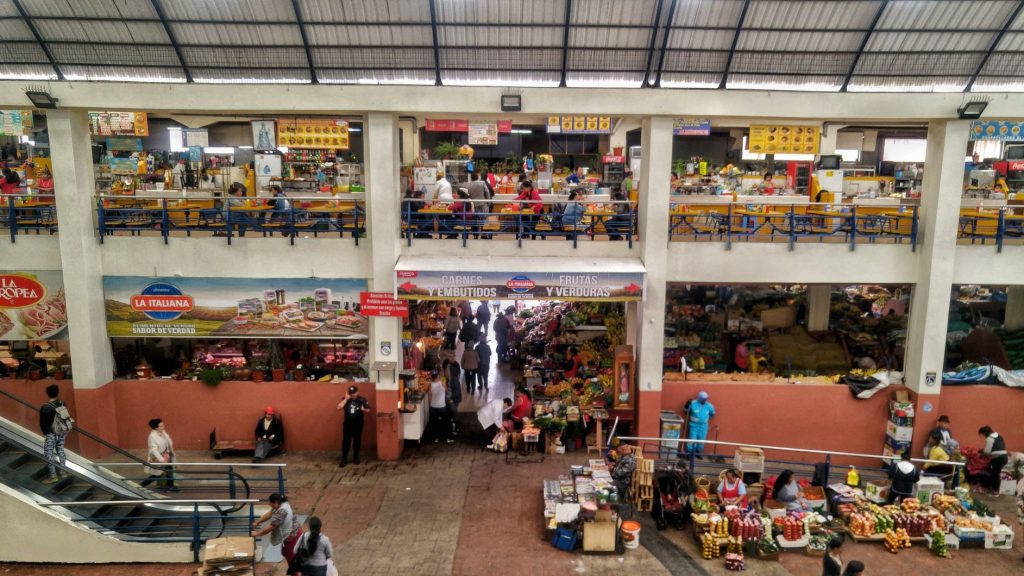
There’s also some unique treats to try. For example, have you ever considered a drink made up of malt and eggs? Well, that’s on the menu too. Or, you can exchange the malt for a Cusquena Negra; a black lager from Peru. My stomach couldn’t handle the thought of malt and eggs, so I enquired about the bottle with Rambo on it. If I could become as ripped as Rambo after a couple of sips of that, it must be good.
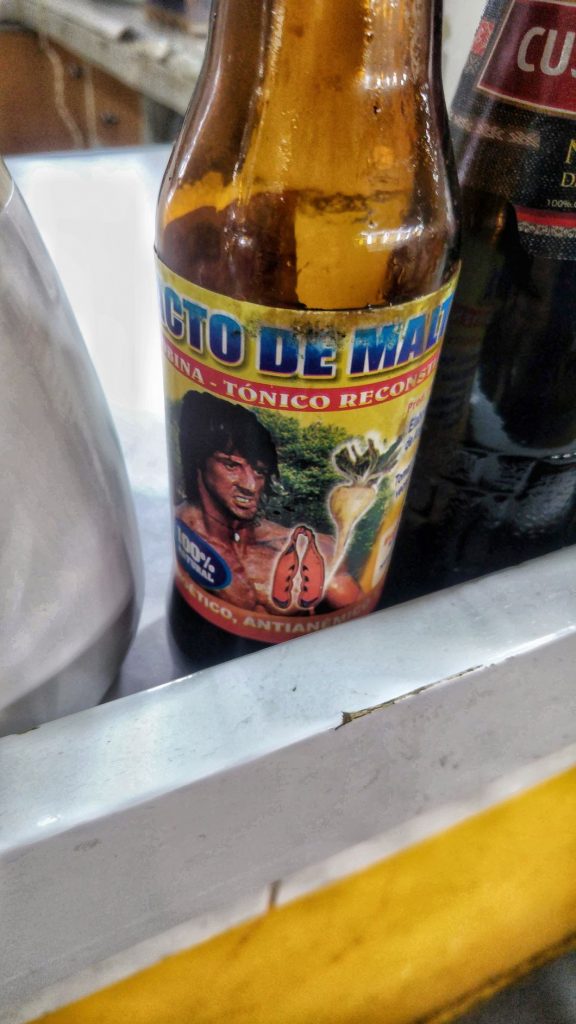
Limpia – A Spiritual Cleansing
The real treat at 10 de Agosto is the Limpia, or ‘spiritual cleansing’. What is a Limpia I hear you ask? Well, Limpia rids the mind, body and soul from ongoing problems. It should remove bad luck, negativity, anxiety and confusion. Despite the mystical cleansing, this isn’t to be mistaken with witchcraft. The ladies who perform the Limpia are not shamen.
The price of a Limpia is $3 USD and for this I got:
- Slapped about for a bit with some flowers.
- Rubbed all over with various lotions.
- Smelled some potent flower alcohol.
- Had an egg rubbed all over me to remove bad spirits and energy from my body.
- The egg was then cracked into a bowl as the lady and I looked at the yolk together. My Spanish is haphazard, but I believe she told me something about my nerves. I don’t know if she captured my nerves in the egg, or was telling me that her Limpia beating had given me nerve damage
- Alcohol was then spat on my face, stomach and down my back. (As a side note, this is supposed to be holy water, but it smelled like it was at least 80% proof). Blowing holy water into one’s face blows away the negative spirits and bad energy.
- A mouth full of flowers were spat all over me.
- The happy ending was a swift crack of my neck and back.
- Finally, a black dot was placed on the top of my scalp.
To be fair, I did feel pretty good after my Limpia (again it could have been the Agua de Pitimas kicking in).
I must say that I now smelled gorgeous and felt ready to hit the town, so away we went.
If you wish to take part in Limpia, they take place between 10AM – 12PM on Tuesday and Thursday.
Museo Sombrero de Paja Toquillo – Cuenca’s Panama Hat Museum
100 metres down the street from 10 de Agosto is the Museo Sombrero De Paja Toquilla. This is the place to go for a truly authentic Panama Hat. Not widely known, the Panama Hat actually originates from Ecuador. Cuenca being the main area of production in the country.
During construction of the Panama Canal, these hats were shipped to workers to shade them from the sun. US President Jimmy Carter was photographed wearing one by the Panama Canal. This led to them being known as Panama Hats. The term stuck, but the world never realised their true origin.
Within Museo Sombrero De Paja Toquilla is a small area documenting how Panama Hats are made. The Panama Hats are graded in to four distinct categories. These are Standard, Superior, Fine and Super Fine. At the highest level of quality, Super Fine Panama Hats have such strong tightly woven fibres, they can hold water without any seeping through. Such exquisite items can take weeks to make. This means the price of Panama Hats vary from as little as $20 up to a few hundred dollars.

Out the back of Museo Sombrero De Paja Toquilla is a great coffee shop. Your coffee is free with the purchase of a Panama Hat, but is still reasonably priced $1.50 for an Americano). From the coffee shop balcony, you also have a gorgeous panoramic view over Cuenca. Perfect whilst savouring your Arabica.
Cuenca Street Food
If it’s time for lunch and you’re on a budget, Calle Larga (which is also home to the Panama Hat Museum) is budget heaven. In a seeming race to the bottom, everything seems to be $1. A huge delicious pizza slice with a drink: $1. Hamburgers: $1. Hot dogs: $1. Ice cream? Well that will cost you $0.50. There are plenty of local restaurants too.
Tomebamba River
Whilst filling your face, take a stroll down the hill and along the Tomebamba River. It’s a peaceful walk and if the weather’s good, you might like to sit for a while on the lush green riverbank and watch the world go by. The Tomebamba River divides Cuenca in two, separating El Centro (The Centre) and Nuevo Pueblo (New Town). It runs all the way down to the Amazon River and out to the Atlantic Ocean on the other side of the continent.

Museo Pumapungo and Shrunken Heads
Following the flow of the Tomebamba River leads to Museo Pumapungo. In this free entry museum you’ll find a fascinating display of indigenous artefacts. Most exhibits have displays in Spanish and give insight into different Ecuador tribes and their practices. The real showstopper is the Shuar section and this is also translated into English. The Shuar are an indigenous Ecuador tribe of people. You can learn about their spiritual practices and see shrunken heads! Yes, you can see real shrunken heads in Cuenca, on display at the Museo Pumapungo. These aren’t some Beetlejuice shrunken head tribute.

The process of shrinking heads (also known as Tsantsa) is not a voodoo ritual. It’s something which the Shuar people did to capture the souls of their enemies and inherit their power. With control of their soul, the enemy could not come back to seek revenge. It also meant the Shuar were able to control the women in the enemies tribe. With the men killed, wives and children would have to work for the Shuar and undertake domestic chores, such as cooking and making chicha (a fermented corn alcoholic drink – worth trying!). The heads of women, children and white conquistadors were not shrunk, as the Shuar considered them to be inferior beings.
The practice of shrinking heads in Ecuador was still happening as recently as 50 years ago. However, Ecuador law no longer permits the practice. In the present day, the tribe sticks to shrinking sloth heads (which are also on display) for their ceremonies. A final point of note; it’s not possible to buy shrunken heads in the gift shop.

Over the last 80 years, Shuar people have been encouraged to integrate into modern Ecuador society. This initiative has been relatively successful and the Shuar’s identity is recognised. Sadly, much of their land has been lost and there’s ongoing conflict in relation to Ecuador mining projects on indigenous lands.
How to Make a Shrunken Head
If you’re interested in learning how to make a shrunken head, the instructions are as follows:
- Cut off head
- Peel skin from skull
- Boil said skin
- Sew up eyes and mouth
- Put rocks in skin
- Leave to dry
- Wear as a necklace
- Show it off to your mates

Pumapungo Inca Ruins
Out the back of the museum are the remains of Pumapungo; a pre-Inca settlement. Originally built by the Cañari people, it was later captured by the Incas and became an important city in their empire. Eventually, the Spanish conquistadors arrived and captured it from them. Destroying the settlement in the process and using the stone to build the city of Cuenca.
The Pumapungo ruins are well worth exploring. It’s easy to imagine how they would have looked in their prime as you stroll along the well maintained terraces. The views from the top of the hill also offer spectacular views across Cuenca. The Incas would have seen enemies coming from miles around!
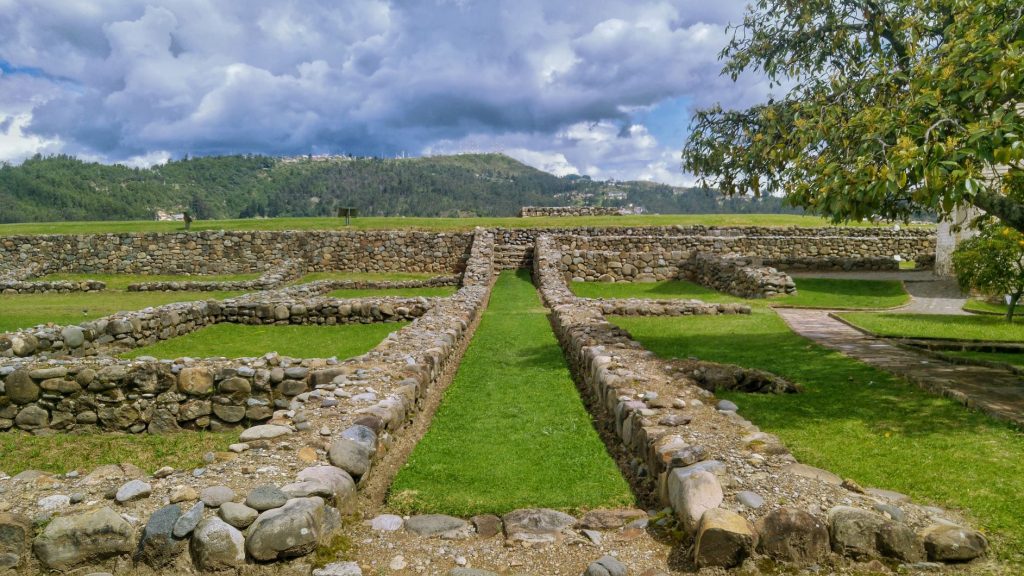
In addition to the ruins, there are gardens with plants that the Incas would have grown. Lamas also walk the paths, chewing the grass to ensure it doesn’t overgrow. However, the lamas are tied to ropes and it would be preferable for them to roam completely free.
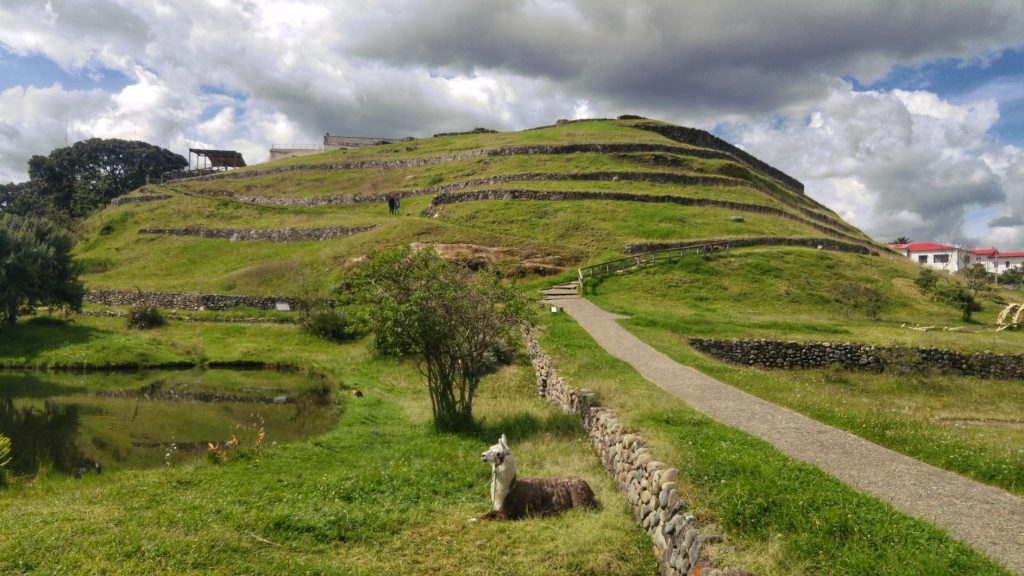
The final part of the gardens is an aviary hosting a wealth of macaws, Amazon parrots, hawks, eagles and more. They all had immaculate coats and so are presumably well looked after. Yet I would expect such birds to be out in their natural habitat roaming free. Nothing indicated they’re rescue animals, so Mueso Pumapungo loses points on that basis.
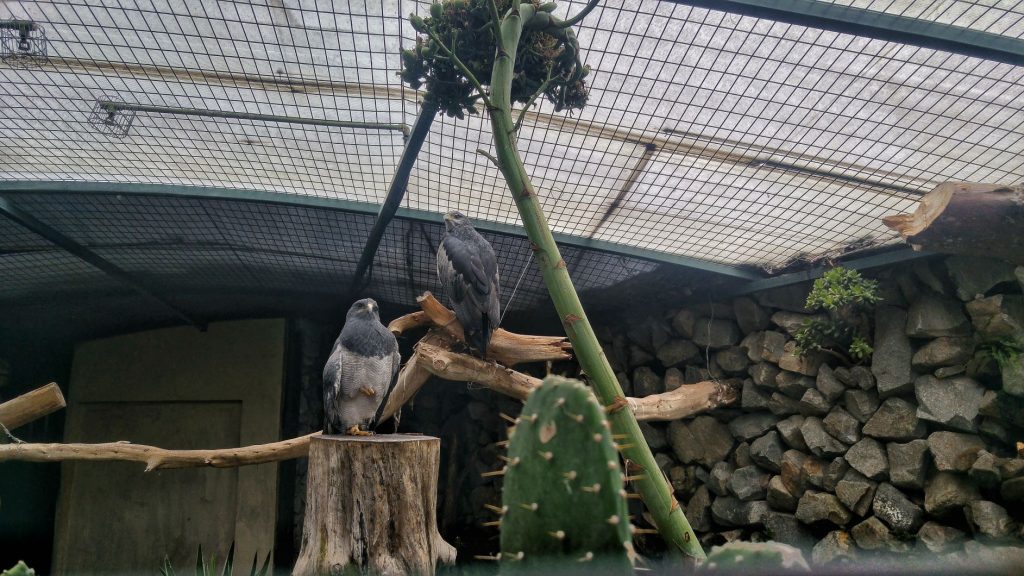
By this time of the day, we decided it was time to head back to the hotel. There were plans to explore the nearby Cajas National Park the next day and I was in a lot of pain from a bike injury on The Galapagos Islands a week earlier. We ended up going to visit Cuenca’s Hospital Vicente Corral Moscoso. That’s another story and not something that makes the list of things to do in Cuenca!
How Long Should I Spend Visiting Cuenca?
You need at least two days to get the most out of the city. It’s very peaceful though and you could take things at a leisurely pace and spend a lot longer there. Cajas National Park is only an hour away and you should spend a day exploring there too.
Accommodation in Cuenca
Cuenca has a wealth of accommodation, from budget backpacker digs, to upmarket hotels. Check here for the best places to stay in Cuenca.
How to get to Cuenca
Cuenca is in the south of Ecuador and easily accessible from the other big cities; Quito and Guyanquil. Quito is eight hours away on a bus which will cost around $12 USD. From Guyanquil it is three and a half hours. From the bus station in Cuenca, you can take a taxi to El Centro for around $2 USD.
Retirement in Cuenca
Cuenca is a popular place for expats to retire to and with it’s relaxing vibe and old world charms, I can see why. If you’re looking to find out more about retirement opportunities, this web-site has lots of valuable information.
Essential Items for Your Trip to Cuenca
It’s always useful to have a guide that helps you plan your travels. The Lonely Planet Guide to Ecuador and The Galapogos Islands is ideal. Also available as Kindle.
The Rough Guide to Ecuador and The Galapagos Islands is also an exceptional travel planner. Also available as Kindle.
I have taken one of these across the world. This power strip is essential for international travel. It charges multiple items at once and takes any kind of international plug. Perfect if you’re in a hostel dorm with limited plug sockets or have a lot of tech to charge.
You’ll need sun cream to fight against Ecuador’s scorching sun. I recommend an eco friendly reef sun cream. This means if you also use it to go swimming, you won’t be harming the underwater environment and animals. You won’t get burned either!
Save the environment and stay hydrated with a bottle that filters your water. This is ideal for travelling overseas where people don’t have the luxury of potable tap water. It will mean you don’t get sick or use a lot of non-recyclable plastic.
Get the best value accommodation in Cuenca here:
SHARE OR PIN THIS POST
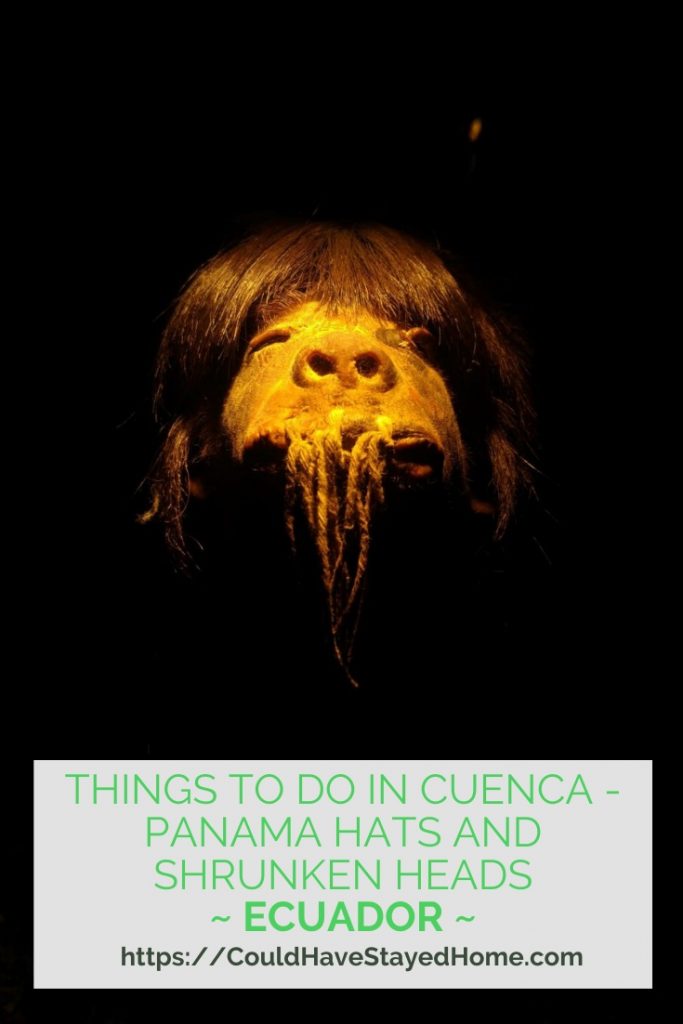
This post contains affiliate links, but we’ll only recommend things that are genuinely useful to fellow travellers. If you buy something through one of those links, you won’t pay a penny more, but we’ll get a small commission. This helps us afford to keep the lights on when writing blog posts in the dark. Thanks!
See our Disclosures for more information.
Nice story.. I think the Panama hat from Montecristi are the Genuine.. Original Panama hats. From Cuenca the hat are more simple and cheaper. I’m wearing my first Panama hat for many years and every year I buy a new one. I like this shop https://andeanstyle.shop – Beautiful hats from Montecristi and perfect fit!
Thanks for reading Mike. A new Panama hat every year sounds like a good buy! 🙂